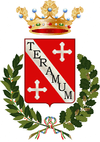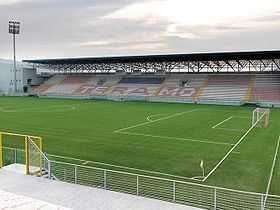Teramo
| Teramo | ||
|---|---|---|
| Comune | ||
| Comune di Teramo | ||
 | ||
| ||
.svg.png) | ||
 Teramo | ||
| Coordinates: 42°40′N 13°42′E / 42.667°N 13.700°E | ||
| Country | Italy | |
| Region | Abruzzo | |
| Province | Teramo (TE) | |
| Frazioni | See list | |
| Government | ||
| • Mayor | Maurizio Brucchi (since June, 2009) | |
| Area | ||
| • Total | 151.88 km2 (58.64 sq mi) | |
| Elevation | 265 m (869 ft) | |
| Population (2011) | ||
| • Total | 54,983 | |
| • Density | 360/km2 (940/sq mi) | |
| Demonym | Teramani | |
| Time zone | CET (UTC+1) | |
| • Summer (DST) | CEST (UTC+2) | |
| Postal code | 64100 | |
| Dialing code | 0861 | |
| Patron saint | Saint Berardo | |
| Saint day | December 19 | |
| Website | Official website | |
Teramo ![]() listen (help·info) (Latin: Interamnia) is a city and comune in the central Italian region of Abruzzo, the capital of the province of Teramo.
listen (help·info) (Latin: Interamnia) is a city and comune in the central Italian region of Abruzzo, the capital of the province of Teramo.
The city, 150 kilometres (93 mi) from Rome, is situated between the highest mountain of the Apennines (Gran Sasso d’Italia) and the Adriatic coast. It is indeed one of the few places where it is possible to reach both the sunny beaches of the Adriatic and the 3,000 metres (9,800 ft) snowcapped Gran Sasso peaks within half an hour from the city centre. Nestled at the feet of Gran Sasso National Park, in Abruzzo, the greenest region of Europe,[1] Teramo stands on a characteristic hillside area where the distinctive terrain features along with the typically mediterranean climate make the territory rich in vineyards and olive groves.
It can easily be reached in one and a half hours by car from Rome via the A24 highway and it is also connected to the A14 highway.
History
The name
Interamna (Greek: Ἰντέραμνα: Eth. Interamnas, Interamnātis), was the name of several cities in different parts of Italy. Its etymology, already pointed out by Varro and Festus, indicates their position at the confluence of two streams.[2] The form "Interamnium" (Greek: Ἰντεράμνιον), and the ethnic form Interamnis, are also found, but more rarely. The name referred to the two rivers Vezzola and Tordino, between which it lies. The name is already corrupted in extant manuscripts of the Liber Coloniarum into Teramne, whence its modern form of Teramo. But in the Middle Ages it appears to have been known also by the name of Aprutium, supposed to be a corruption of Praetutium, or rather of the name of the people Praetutii, applied (as was so often the case in Gaul) to their chief city. Thus the name Abrutium is present among the cities of Picenum enumerated by the Geographer of Ravenna (iv. 31); and under the Lombards a comes Aprutii is mentioned. The name has been retained in that of Abruzzo, now a region of Italy.
Pre Roman age: From 7th to 5th century BC
Teramo has very ancient origins. The settlement of the 1st BC millennium along with some buildings of the ancient people of Italy were the object of very recent archaeological excavations. The most ancient historical remains were found in the outskirts of the city, precisely, in the neighborhood Madonna della Cona, where, among many, a burial place with a dagger and a halberd were found. Allegedly, the development of the old settlement was due to the commercial center founded by the Etruscan and Phoenician civilization.
The Praetutii (The ancient people of Teramo)
According to the Roman author Sextus Julius Frontinus, the ancient Perut or Pretut (hill surrounded by waters) strongly developed in dimensions and importance until it became the capital of Praetutium and Conciliabulum where the Praetutii people lived.
Roman age

- 295 BC, In the Battle of Sentinum, the Romans defy the Italian confederation (Sabellians, Etrusci, Umbri and their allies Gauls). With this battle the Samnite Wars begin.
- 290 BC, The Sabine area along with the Praetutii’s region is occupied by the legions sent by the consul general Manius Curius Dentatus.
The city takes its latin name of Interamnia Preatuttorium (City of the Preaetutii between two rivers) allegedly simple translation of the toponym “Petrut”. During the Age of Augustus Intermania is included in the fifth district: The Picenum (the VI district was Umbria and the IV was Samnium). The area of the current province is divided from south to north in Ager Hatrianus, Ager Praetutianus and Ager Palmense. During this period Interamnia is:
- Conciliabulum: Place of meeting and market
- Praefectura iure dicundo
- Municipium, after the 2nd social war
- Sulla's colony. In this period the city loses the status of Municipium because of the participation of Lucius Cornelius Sulla in the Second Social war (91-88 BC), but the city will subsequently regain it for expressed will of Julius Caesar.
- During the Roman age, thanks to its nearness to the capital of the empire, the city lives a very prosperous and favorable moment as the numerous mosaics, theater, thermal baths and the amphitheater remains evidence. As historians like Ptolemy, Livy and Pliny remember, the city reached its best period under the emperor Hadrian, with the constructions of the temples dedicated to Mars and Apollo.
The Goths and the Byzantines
A first destruction of the city in the year 410 by the Visigoths under Alaric I is testified. Even though the information about this age is very uncertain, it is said that the presence of the Goths in Interamnia is active until 552-554 A.d. Right after the Gothic War, the city is a possession of the Byzantine empire. Teramo is then anew included in the Marchia Firmana, under the Greek Exarchate of Ravenna. The city is now governed by a count of the Marchia Firmana.
12th century
- 1129, After the Lombards’ invasion in Abruzzo, the city becomes territory of the Normans settled in the duchy of Apulia.
- 1140, Teramo is possession of Roger II of Sicily, the first king of the Kingdom of the Two Sicilies.
- 1153, A not well-identified subject called Teodin, helps build the church and the cloister of Sant’Angelo delle Donne; subsequently it will take the name of Madonna Delle Grazie.
- Teramo is destroyed by the Norman army of Robert di Loretillo. Only the tower of Piazza Sant’Anna was saved from this sack; from this moment on it will be called Torre Bruciata (burnt tower).
- 1176, The Romanesque construction of the Duomo of Teramo is completed.
13th century "Age of Freedom"
- 1268, End of House of Hohenstaufen dominion and beginning of the one of the House of Anjou.
14th century
During the House of Anjou dominion, Teramo is subjected to a new period of majesty and prosperity: the ecclesiastical authority of the Aprutina Diocese, led by the bishops Rainaldo Acquaviva, Niccolò degli Arcioni (1317), Stefano da Teramo (1335) and Pietro di Valle (1366) gives new life to the city. This is witnessed by the construction of beautiful castles, churches, cloisters and palaces along with the great privilege granted by the sovereigns. The city changes its architectural face, both in the old district and the new. It turns into a frontier city and in the very sense of the word, it is named Gate of the Reigns.
15th century

- Period defined by the struggles between the most important families of the city (De Valle and Melatino). The exemplary hanging of 13 followers of Melatino’s family is still remembered in a stone shield in the very center of the city. The monument represents two heads with their tongues out under the writing “A lo parlare agi mesura” (mind what you say).[3]
- During the first years of the century, the tyrant Antonello de Valle is assassinated and therefore his beautiful castle, which was located in a square known nowadays as Piazza Garibaldi, is demolished. The legend says that the belligerence between the families ended thanks to the women of the city who proclaimed a strike of affection. Despite the internal struggles, the city lives a very developed cultural period. Artists like Jacobello del Fiore and Nicola da Guardiagrele give pearls of beauty to the city and the commercial relationship with Tuscany and Venice turns Teramo into a cultural shrine.
- June 1442, The Kingdom of Naples is a property of Alfonso V, King of Aragon.
16th century
- 1504, The kingdom of Naples passes to Ferdinand II of Aragon, king of Spain. This begins the Spanish dominion to Abruzzo and all of Southern Italy.
- After the death of Ferdinand II, Francis II of the Two Sicilies is the new king, and Teramo is sold to the Duque of Atri for 40.000 ducats. Because of this, the people of Teramo strongly rebel. It is indeed said that among the night from the 17th to the 18th of November 1521, the troops of the Duke who were surrounding the city fled scared by the vision of the Virgin Mother with Saint Berardo defending the city. The miracle of Saint Berardo, patron saint of the city was born.[4]
17th century
18th century
- 1707, After of the War of the Spanish Succession, the House of Hasburg has the domain of the whole Kingdom of the Two Sicilies for 27 years.
- 1744, German invasion and the beginning of a new movement based on the Age of Enlightenment philosophy in Teramo. It is led by several intellectuals, among which outshines Melchiorre Delfico, a notable poet, composer and Italian philosopher.
- 1798, The French troops enter Teramo. Even though they are initially sacked by the citizens, they come back a few days later, ruthless destroying the whole city.
19th century
- March 15, 1806, Napoleon defeats the troops of Ferdinand I of the Two Sicilies. Teramo is officially a French possession.
- 1815, The city is once again, a possession of the Kingdom of Naples.
- 1832, Ferdinand II of the Two Sicilies visits the city for the first time.
- 1844, Ferdinand II of the Two Sicilies pays his second visit to the city.
- 1847, 3rd and last visit of Ferdinand II of the Two Sicilies to the city.
- 1890, The Astronomy Observatory of Collurania is established.
Modern age
- 1925, The first Italian Psychoanalytic Society is founded in Teramo.
- 1934, The palace of Convitto Nazionale and Melchiorre Delfico library is completed and inaugurated in the square entitled to Dante Alighieri.
- 1941, Foundation of Zoo Profillatico Sperimentale Institute.
- June 25, 1943, The German troops arrive in Teramo and proceed to Bosco Martese. where they fight against the men of Resistance movement of Teramo. The episode will be remembered as “the battle of Bosco Martese”.[5]
- 1972, First edition of Interamnia World Cup (still in progress).
- 1984, The Gran Sasso Tunnel is officially opened.
- June 30, 1985, Official visit of Pope John Paul II.
- 1989, Teramo is nominated by Unicef “A city open to the world”.[6]
- June 1991, Cardinal, Joseph Ratzinger leads in the University of Teramo on a convention called “Capitalism and Social Rights”.
- 1993, Autonomy and official foundation of the University of Teramo.
- September 15, 2005, Official visit of the President of the Italian Republic Carlo Azeglio Ciampi.
- November 22, 2008, Official visit of the Prime Minister Silvio Berlusconi.
- April 2009, Even though the tremors are strongly felt in the city, Teramo is not damaged by L’Aquila Earthquake.
- December 16, 2009, The city and the province of Teramo sign a protocol of friendship and cooperation with the provincial council of Ávila in Spain.[7]
Geography
Climate
The climate is fresh-temperate. In the coolest month (January) temperatures average 5.5 °C (42 °F), and in the warmest month (July) they average 24 °C (75 °F). In the winter time though they can experience copious amounts of snowfall, as in 2012. The precipitations are not frequent and mostly concentrated in late spring. The summers are characterized by days of somewhat intense heat.
| Climate data for Teramo (2007) | |||||||||||||
|---|---|---|---|---|---|---|---|---|---|---|---|---|---|
| Month | Jan | Feb | Mar | Apr | May | Jun | Jul | Aug | Sep | Oct | Nov | Dec | Year |
| Average high °C (°F) | 14 (57) |
14 (57) |
15 (59) |
20 (68) |
24 (75) |
28 (82) |
32 (90) |
30 (86) |
24 (75) |
17 (63) |
13 (55) |
13 (55) |
20.3 (68.5) |
| Average low °C (°F) | 5 (41) |
6 (43) |
7 (45) |
10 (50) |
14 (57) |
17 (63) |
21 (70) |
19 (66) |
14 (57) |
11 (52) |
6 (43) |
5 (41) |
11.3 (52.3) |
| Precipitation mm (inches) | 14 (0.55) |
26 (1.02) |
67 (2.64) |
25 (0.98) |
92 (3.62) |
62 (2.44) |
0 (0) |
30 (1.18) |
30 (1.18) |
30 (1.18) |
157 (6.18) |
90 (3.54) |
623 (24.51) |
| Source: National Weather Service | |||||||||||||
Neighborhoods
|
|
|
Frazioni
Cannelli, Caprafico, Castagneto, Castrogno, Cavuccio, Cerreto, Chiareto, Colle Caruno, Colleatterrato Alto, Colleminuccio, Colle Santa Maria, Forcella (located about 11 km (7 mi) from Teramo and dominating the Vomano Valley, Frondarola, Galeotti, Garrano, Garrano Basso, Magnanella, Miano, Monticelli, Nepezzano, Pantaneto, Poggio Cono, Piano D'Accio, Piano della Lenta, Poggio San Vittorino, Ponzano, Putignano, Rapino, Rocciano, Rupo, Sardinara, Saccoccia, San Nicolò a Tordino (important industrial zone located along the axis joining Teramo to the sea), San Pietro ad Lacum, Sant'Atto, Scapriano, Sciusciano, Sorrenti, Spiano, Tofo Sant'Eleuterio, Tordinia, Turri, Valle San Giovanni, Valle Soprana, Varano, Villa Falchini, Villa Gesso, Villa Ripa, Villa Romita, Villa Stanghieri, Villa Taraschi, Villa Viola, Villa Vomano (located in the Vomano valley and an important link to the autostrada).
Main sights
Roman Theatre
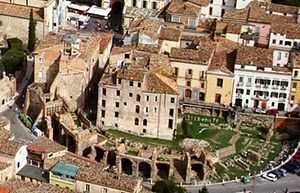
The Roman theatre was built in the early 2nd century under emperor Hadrian. It is nearby the Duomo of Teramo. The walls are 10 ft (3.05 m) long and the estimated capacity was 3000 spectators. Over the centuries, the structure was mined for building materials. In 1918 its ruins were rediscovered, and in 2007, a project to rebuild the theater was planned, incurring in the demolition of Palazzo Adamoli in 2011. The poet Gabriele D’Annunzio said of this site that “The remains of the theatre of Interamnia proves its ancient Roman majesty”.[8]
Roman Amphitheater
The 700 ft (213.36 m) wide building was a Roman amphitheater. During Middle Age, the site was used as a fortress to protect the city.
Duomo
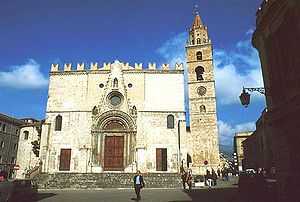
Construction of the Basilica Cathedral of Santa Marria Assunta and Saint Berardo began in 1158 under the bishop Guido II; it was built to house the relics of St Berardo da Pagliara. It was consecrated and completed in 1176. Most of the material used to build were spolia from the theater and the amphitheater. The tower built in 11th and 12th centuries has three bells and it is 165 ft (50.29 m) long. It houses the silver canopy of Nicola da Guardiagrele, built from 1433 to 1448. Since 2007, it is possible to visit the crypt of Saint Berardo da Pagliara, the patron saint of Teramo.
Casa del Mutilato
The “Church della Misericordia” was built after the plague of 1348, and was rebuilt in 1928, as a Casa del Mutilato. It contains a fresco by Giacomo da Campli (15th century). In 1514, the queen Joan II of Naples, visited to revere a crucifix said to contain a thorn from the crown of Christ.[9]
Mosaico del leone
It is by far the symbol of the archeological history of Teramo. Found in 1891 during the construction of Palazzo Savini, the mosaic underwent centuries of dampness. However, due to the impeccable work of restoration specialists it still is a perfect representation of the works of urban archeology. The value of the masterpiece proves that a long time ago the city had an important tradition and a real school for the masters of mosaic.
Convitto Nazionale
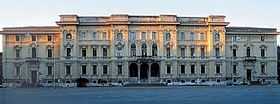
Built in 1934 it was the first site for the faculty of Law in Teramo in 1817.
Vescovato (Bishop's Palace)
It was most likely erected in 1374 with columns of stones and travertine from Civitella del Tronto. It still is the residence of the bishop and the main offices of the Aprutina administration. Ever year on the Good Friday and the preceding night, the bishop leads an night-time procession. Legend that the Virgin Mother, wanders from church to church looking for her son.[10] Although the procession leaves at 4am, the tradition still attracts many Teramani during Easter.
Castello della Monica
Don Gennaro Della Monica (born 1837) and a history painter, designed this neo-gothic castle for himself and his family in Piazza Garibaldi in the 19th century.[11]
Madonna delle Grazie
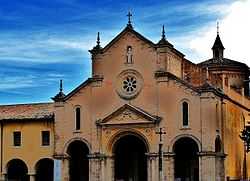
The church stands "fuori porta" (outside of the Roman’s gates that surrounded the city); the church along with the inner cloister are open to the public.
Sor Paolo
Thought to be a statue of an Roman patrician, the citizens of Teramo call the statue Sor Paolo. In his left-hand people stuffed satires and letters of complaint about the city’s most powerful people.
Antico Manicomio (Old Insane Asylum)
It was once considered the biggest psychiatric hospital of central/southern Italy.The structure was erected first in 1323. Marco Levi Bianchini, an Italian psychiatrist active here, who corresponded with Sigmund Freud, founded in Teramo the Italian Psychoanalytic Society.[12] The gate of the hospital has a sign reading: Here are the few perhaps not even the real ones.[13]
Piazza Sant’Anna
Square in the city with an old church. Recent remains found appear to belong to the old Torre Bruciata and to a Roman house of the 2nd century BC.
Palazzo Castelli

The ex Casa Muzii (named after the owner's last name) was built in 1908 in Corso Cerulli. It is an example of art nouveau style.
Culture
An art exhibit, Maggio Festeggiante, is held each May, and the Teramo Literary Prize and the Interamnia World Cup, an international event with athletes coming from all over the world. A week in October is dedicated to an international photography of film show.
University of Teramo
The University of Teramo offers 5 faculties, 24 degree courses, 35 Masters, 6 postgraduate schools and 10 departments. The entire 50,000 sq m of the Coste Sant'Agostino Campus holds the faculties of Law, Communication Sciences, Political Science and Economics. The faculties of Agriculture and Veterinary Medicine are spread out across the city and in the surrounding areas of the province.[14]
Museo Civico d’Arte e Pinacoteca di Teramo
The archeological museum houses sculptures and ruins of the most ancient version of Teramo; from prehistory to the Roman Empire Age. The pinacoteca has a huge collection of canvas, paintings, and sculpture for permanent and stable collections.
Osservatorio Collurania
The astronomer Vincenzo Cerulli, on the 2nd of October 1910, discovered a new asteroid, to whom he gave the name of Interamnia.[15] The Astronomy Observatory of Collurania has a huge telescope and a wide collection of devices from the scientific instruments museum.
Istituto Zooprofilattico sperimentale
Founded September 2, 1941 the ““Istituto Zooprofilattico Sperimentale dell’Abruzzo e del Molise G. Caporale" (IZSAM) is one of the ten experimental zooprophylactic institutes in Italy. Its job is to inspect animals' sanitary conditions, their health conditions, the origin of products, veterinarian vigilance, education, experimentation and scientific investigation, and the ambient care.
Government

At the municipal level, the City of Teramo has a council made up of the mayor and councilmen that are elected every five years. In Italy every citizen over 18 has the right to vote.
The current Mayor Maurizio Brucchi was elected in June 2009, as the ex Mayor Gianni Chiodi resigned to be proposed (and then elected) as a candidate of the Abruzzo region president.
| |
|
|
|---|---|---|
| Gianni Chiodi | Al centro con Chiodi | 2004 |
| Maurizio Brucchi | The People of Freedom | 2009 |
International relations
Twin towns — sister cities
Teramo is twinned with:
-
 Ribeirão Preto, BRA.[16]
Ribeirão Preto, BRA.[16] -
 Prague, CZE.[17]
Prague, CZE.[17] -
 Strovolos, CYP.[18]
Strovolos, CYP.[18] -
 Memmingen, GER.[19]
Memmingen, GER.[19] -
 Rishon LeZion, ISR.[20]
Rishon LeZion, ISR.[20] -
 Berane, MNE.[21]
Berane, MNE.[21] -
 Gorzów Wielkopolski, POL.[22]
Gorzów Wielkopolski, POL.[22]
Notable people
People born in or around Teramo include:
- Berardo da Pagliara, (?-1123), bishop and patron saint of the city and diocese
- Melchiorre Delfico, (1744–1835), Enlightenment philosopher
- Melchiorre Delfico, (1825–1895), caricaturist
- Giacinto Pannella, (1847–1927), author
- Vincenzo Cerulli (1859–1927), astronomer
- Ivan Graziani, (1945–1997), singer-songwriter
- Marco Pannella (1930-now), europolitician
- Francesco Possenti, (1838–1861), also known as Saint Gabriel of Our Lady of Sorrows. Patron saint of Abruzzo
- Marco Reginelli, (1897–1956) underworld boss
- Felice Centofanti, (1969–present), a former soccer player
- Marco Mordente, (1979–present), Basketball player
- Gianni Di Venanzo, (1920–1966), cinematographer
Sport
Basket

Teramo Basket had been playing in Serie A, the Italian top division, for 10 years until the end of the 2011-12 season. Due to a heavy situation of bankruptcy the team folded in July 2012 and disappeared from any basketball league. In the past Teramo Basket had been an important launch pad for both Italian and American players such as Clay Tucker, Jaycee Carroll, and more.
Football
Teramo Calcio is one of the oldest football clubs in the history of the Italian league, founded on July 15, 1913. In the current season 2013/2014 it plays in the Italian Lega Pro Seconda Divisione. The new Stadio Comunale hosts concerts and football matches.
Handball
H.C. Teramo Handball are two handball teams (male and female) playing in the major handball championship in Italy. The feminine team won the Italian top league in 2012. The city hosts the Interamnia World Cup every July, the handball world cup with more than 30 national teams from all over the world.
Other sports
Other sports practiced in Teramo are:
- Rugby, Teramo rugby is the major team in the province
- Water polo
- Rallying with the Rally of Teramo
- Maratonina pretuziana is celebrated every year. It is a marathon race where many of athletes from all over the world participate.
- Teramo torball is the team that has won the most titles in Italy; it has also won a Champion’s league.
Gastronomy

Due to the heterogeneity nature of its territory, the provincial Teramo gastronomy is known for its variety and richness. Typical ingredients include agnello (lamb), peperoncino (hot pepper), formaggio pecorino (sheep milk cheeses), and slow roasted pork. Best-known is the extra virgin olive oil produced in the local farms on the hills of the city, marked by the quality level DOP and considered one of the best in the country.[23] Colline Teramane (Teramo Hills) has become a trademark and are one of the most significant areas where extra-virgin olive oil and the Abruzzo wines are produced.[24] Renowned wines like Montepulciano DOCG and Trebbiano d'Abruzzo DOC are considered amongst the world’s finest wines.[25] In 2012 a bottle of Trebbiano d'Abruzzo Colline Teramane ranked #1 in the top 50 Italian wine award.[26]
Typical dishes from Teramo and the surrounding communities include the following:
- Arrosticini - Maybe the best-known dish of Teramo’s gastronomy they are typically made from castrated sheep's meat (mutton), cut in chunks and pierced by a skewer.
- Caggiunitti - deep fried almond fritters typically made with chocolate and chestnuts.
- Maccheroni alla chitarra - a flat, stringlike egg pasta which takes its name from the wooden instrument, basically a wooden frame strung with fine metal wire, called a chitarra (guitar), used to cut the pasta.
- Mazzarelle d'agnello - lamb's lung and innards wrapped in beet greens or chard and braised in white wine or tomato sauce. Not for the feint of heart and not to be confused with mozzarella cheese.
- Scrippelle - This dish is served in the throughout the Teramo province and is somewhat similar to French crepes, although typically made without milk. There are two common variations. The first is scrippelle 'mbusse - (dialect for scrippelle in brodo or broth) and consists of scrippelle rolled up in Pecorino or Parmesan cheese and served in chicken broth. A second variation is timballo - scrippelle layered with ragù, meat or tiny meatballs (polpettine), various cheeses such as mozzarella, and sometimes peas (piselli).
- Tacchino alla canzanese - a popular dish in the nearby provincial town of Canzano. Made by slow baking a turkey in gelatin (and ancient method of preserving meat) and typically served cold.
- Vino cotto - a fortified wine, found also in the Marche region, produced by slowly boiling down grape juice before fermentation and aging thus producing a sweet and rich dessert-type of wine. Consumed both straight up and in cooking.
- Virtù - a vegetable soup typically prepared in May of each year to celebrate spiritual redemption and the bountiful virtues of the Earth. It is made with a wide variety of locally-grown vegetables and typically includes "annit" (a type of wild fennel).
City connection and Tourism
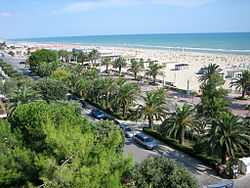

- Teramo is located 150 km (93 mi)away from Rome. It is connected to the capital of Italy through the A24 highway called Teramo-Rome. The public transportation to get to Teramo from Rome leaves from Tiburtina Bus Station in Rome and the two cities are only connected by bus. Teramo can also be reached straight from the two airports of Rome through the service of several airport transfer companies which offer several daily trips.
- The nearest airport is the “Abruzzo Airport”. It is 40 miles away (65 km) from the city center and it is connected to the city through highway A14 in less than one hour by car.
- By railways, Teramo has a straight connection to Pescara and it is also possible, after a fast change in the near station of Giulianova, to reach cities like Milan, Bologna, Bari, Venice, Turin etc.
- A considerable part of the Gran Sasso National Park is nestled in the province of Teramo. Amongst the main natural attractions there are Monti Gemelli (Twin Mountains), which are often taken as one of the symbols of the province of Teramo and the Corno Grande, the highest peak in the Apennines, also home of Calderone, Europe's southernmost known glacier .
- The nearest Gran Sasso ski resorts and slopes are 25 miles away (40 km) (Prato Selva, Prati di Tivo). They are reachable by SS 80 route.
- The nearest beaches reside 14 miles away (23 km) away in the nearby town of Giulianova.
- Civitella del Tronto is included in the official list of the Italian most beautiful villages.[27] Residing 11 miles away (18 km) from the city center, it is reachable through SS24 route. The fortress of Civitella is the most visited monument in the whole Abruzzo region.[28]
- Castelli is a village 25 miles away (40 km) from Teramo. It is known for its maiolicas.
- The Shrine of Gabriel of Our Lady of Sorrows with average of 2 million visitors per year is one of the 15 most visited sanctuaries in the world.[29] It is 15 miles away (28 km) from Teramo and they are connected through highway A24 (Teramo-Rome).
Trivia
- In the 18th century Teramo was dubbed by Sir John Acton "The Athens in the Kingdom" due to the presence of intellectuals in the city.[30]
- In 1989 Teramo was nominated by Unicef “A city open to the world” owing to the aptitude of integration and cultural exchanges.[31]
- PalaScapriano (the basketball centre) dome is the biggest in the world. Bigger than the dome of the Pantheon and the one of the Cathedral of Florence.[32]
References
-
 This article incorporates text from a publication now in the public domain: Smith, William, ed. (1854–57). "article name needed". Dictionary of Greek and Roman Geography. London: John Murray.
This article incorporates text from a publication now in the public domain: Smith, William, ed. (1854–57). "article name needed". Dictionary of Greek and Roman Geography. London: John Murray.
- Notes
- ↑ Parco Nazionale d'Abruzzo Lazio e Molise | Natura | Fauna
- ↑ "inter amnes", Varro L. L. v.28, Fest. v. Amnes, p. 17, Müll.
- ↑ http://www.europamedievale.eu/armoriale/armoriale.asp
- ↑ http://www.ilcorrieredabruzzo.it/cultura/30269-teramo-nostra-e-la-madonna-delle-grazie.html
- ↑ http://boscomartese.wordpress.com/2009/10/10/hello-world/
- ↑ http://www.interamniaworldcup.com/en/teramo-citta-aperta-al-mondo/
- ↑ http://www.provincia.teramo.it/sala-stampa/avila-la-provincia-in-spagna-per-un-gemellaggio-allinsegna-della-sostenibilita-ambientale-insieme-al-presidente-catarra-anche-il-sindaco-di-teramo-maurizio-brucchi/
- ↑ http://www.treccani.it/enciclopedia/teramo_(Enciclopedia-dell'-Arte-Antica)
- ↑ http://www.teramoculturale.it/index.php?id=20&itemid=269
- ↑ http://www.lifeabruzzo.it/288/181/news/il_venerdi_santo_a_teramo.html
- ↑ Garollo, Gottardo (1907). Ulrico Hoepli, ed. Dizionario biografico universale. Editore Libraio della Real Casa, Milan. p. 656.
- ↑ http://www.weagoo.com/it/card/5390/antico-manicomio
- ↑ http://www.raccontidiviaggi.info/nazioneitalia/lombardia/itinerarilombardia/724-teramo.html
- ↑ http://www.unite.it/UniTE/Engine/RAServePG.php/P/35941UTE2833
- ↑ http://physics.bgsu.edu/~layden/Anim/Asteroids/interamnia.htm
- ↑ "Ribeirão Preto - Coordenadoria de Comunicação Social". Ribeiraopreto.sp.gov.br. Retrieved 2013-03-12.
- ↑ "MC Praha 7: The visit from Teramo in Prague 7". Praha7.cz. 2007-05-16. Retrieved 2013-03-12.
- ↑ "Union of Cyprus Municipalities". Ucm.org.cy. Retrieved 2013-03-12.
- ↑ Germany (2012-01-17). "Memmingen, Memmingen, Bavaria, Germany - City, Town and Village of the world". En.db-city.com. Retrieved 2013-03-12.
- ↑ "עיריית ראשון לציון - Foreign Relations". Rishonlezion.muni.il. Retrieved 2013-03-12.
- ↑ Montenegro. "Berane, Montenegro - City, Town and Village of the world". En.db-city.com. Retrieved 2013-03-12.
- ↑ http://egorzow.pl/aktualnosci/Wspołpraca-Gorzowa-z-włoskim-miastem-Teramo-zacieśniona_10224.html
- ↑ http://www.hotelposeidontortoreto.com/en/abruzzi-wine-and-food_31.html
- ↑ http://www.hotelposeidontortoreto.com/en/abruzzi-wine-and-food_31.html
- ↑ http://www.winecountry.it/regions/
- ↑ http://www.winenews.it/print/the-winenews-corner/28904/the-best-italian-wine-is-trebbiano-dabruzzo-2007-by-valentini-then-barolo-reserve-monprivato-c-dmorissio-2004-by-mascarello-and-sassicaia-2009-by-san-guido-estate-the-best-italian-wine-awards-the-50-best-wines-of-italy
- ↑ http://www.borghitalia.it/?lang=en
- ↑ http://www.corriere.it/cultura/speciali/2010/visioni-d-italia/notizie/3civitella-del-tronto-Serenissimi-e-borbonici-insieme-per-disfare-l-Italia_b3bc7456-550c-11df-a414-00144f02aabe.shtml
- ↑ http://turismo.provincia.teramo.it/art-and-culture/churches/shrine-of-saint-gabriele-dell92addolorata-96-isola-del-gran-sasso/?set_language=en
- ↑ http://www.altraparola.it/terza-pagina/2984-teramo-diventa-capitale-della-cultura-classica.html. Missing or empty
|title=(help) - ↑ "A Case Of Excellence". Interamnia World Cup. Retrieved 2013-03-12.
- ↑ "Palascapriano (Cn)". informazione.it. Retrieved 2013-03-12.
Bibliography
- G.Cappelli y R.Faranda, Storia della Provincia di Teramo dalle origini al 1922, Tercas, Teramo, 1980;
- Riccardo Cerulli, Storia illustrata di Teramo, Teramo, Edigrafital, 1970;
- Mutio De' Mutj Muzio Muzii, Della Storia di Teramo dialoghi sette, notes of Giacinto Pannella, Teramo, Tip. del Corriere Abruzzese, 1893, ;
- Niccola Palma, Storia ecclesiastica e civile della ... città di Teramo e Diocesi aprutina, 5 volumes, 1st edition: Teramo, Angeletti, 1832-1836; 2nd edition: edited by Vittorio Savorini, Francesco Savini, Teramo, Fabbri, 1890-1893; 3rd edition:Teramo, Tercas, 1978-1981, ;
- Francesco Savini, Uno sguardo alla storia municipale di Teramo. Dai tempi più remoti all'èvo moderno, in "Rivista abruzzese di scienze lettere ed arti" - (Rasla), 1st year (1886), n. 3, May, p. 97-105, ;
- Francesco Savini, Il comune teramano nella sua vita intima e pubblica dai piu antichi tempi ai moderni : racconti e studii seguiti da documenti e da tavole, Roma, Forzani e C., 1895, ;
- Francesco Savini, Degli Stemmi e dei Gonfaloni di Teramo e dei suoi quattro quartieri, in "Teramo. Bollettino mensile del Comune di Teramo", (1933), n. 7, July, p. 3-6, ;
External links
| Wikimedia Commons has media related to Teramo. |
- Abruzzo region
- Interamnia World Cup
- Municipality of Teramo
- Province of Teramo
- Teramo Beaches Live Webacam
- Teramo Forecast
- Teramo on GoogleEarth
- Teramo Mountains Webcam
- University of Teramo
